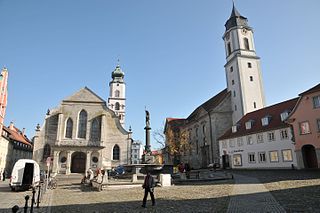
A nun is a woman who vows to dedicate her life to God, typically living under vows of poverty, chastity, and obedience in the enclosure of a monastery or convent. The term is often used interchangeably with religious sisters who do take simple vows but live an active vocation of prayer and charitable work.

A convent is a community of monks, nuns, religious brothers or, sisters or priests. Alternatively, convent means the building used by the community. The word is particularly used in the Catholic Church, Lutheran churches, and the Anglican Communion.
A religious order is a lineage of communities and organizations of people who live in some way set apart from society in accordance with their specific religious devotion, usually characterized by the principles of its founder's religious practice. It is usually composed of laypeople and, in some orders, clergy. Such orders exist in many of the world's religions.

The Bridgettines, or Birgittines, formally known as the Order of the Most Holy Savior, is a monastic religious order of the Catholic Church founded by Saint Birgitta in 1344 and approved by Pope Urban V in 1370. They follow the Rule of Saint Augustine. There are today several different branches of Bridgettines.

The Catholic Church in Norway is part of the worldwide Catholic Church, under the spiritual leadership of the Pope, the Curia in Rome and the Scandinavian Bishops Conference.

The Abbey Pax Mariae, more commonly referred to as Vadstena Abbey, situated on Lake Vättern in the Diocese of Linköping, Sweden, was the motherhouse of the Bridgettine Order. The abbey started on one of the farms donated to it by the king, but the town of Vadstena grew up around it. It was active from 1346 until 1595.

Tautra Abbey was a monastery of Cistercian monks founded in the 13th century on the island of Tautra in the Trondheimsfjord in Norway. The island is part of the municipality of Frosta in Trøndelag county, Norway. Tautra Abbey was dissolved during the Reformation in Scandinavia when its lands were passed to the Crown, but the sizeable ruins of the church are still to be seen. The ruins of the former abbey are relatively well preserved and are a favorite tourist destination.

The Abbey of Our Lady of the Mississippi is located near Dubuque, Iowa. The nuns there are members of the branch of the Order of Cistercians of the Strict Observance, commonly referred to as Trappistines. They are a part of the Catholic Church in the Archdiocese of Dubuque.

Cistercian nuns are female members of the Cistercian Order, a religious order belonging to the Roman Catholic branch of the Catholic Church.

Lindau Abbey was a house of secular canonesses in Lindau on the Bodensee in Bavaria, Germany, which stands on an island in the lake.

Munkeby Abbey was a Cistercian monastery near the village of Okkenhaug in the municipality of Levanger in Trøndelag county, Norway. It was located about 5 kilometres (3.1 mi) east of the town of Levanger. The name "Munkeby" in Norwegian means Place of the Monks. It was closed during the Protestant Reformation. Today the former abbey is the sight of medieval ruins which are managed by the Society for the Preservation of Ancient Norwegian Monuments.

Schönau Abbey is a monastery in the Roman Catholic Diocese of Limburg on the outskirts of the municipality of Strüth in the Rhein-Lahn district, Rhineland-Palatinate, Germany. It is often referred to as Schönau Abbey of Nassau or Schönau Abbey in Taunus, in order to differentiate it from the other Schönau Abbey in Baden-Württemberg. This Schönau Abbey is most well known as the convent of St. Elizabeth of Schönau.
The suppression of monasteries refers to various events at different times and places when monastic foundations were abolished and their possessions were appropriated by the state.